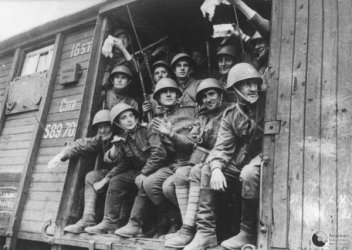
Soldiers of the General Berling's Polish First Army go to the front
Beachhead "between bridges", Warsaw, September 1944
At the early afternoon hours of September 19th, 1944, the artillery fire from the east bank of Vistula grew stronger. Polish and Soviet artilleries were shelling the German positions situated alongside the river and some targets located further away. At the same time Soviet and Polish airplanes began bombing specific targets in the area of the Saxon Garden, the Warsaw Main Rail Station, the National Museum, the over-passes of the Poniatowski Bridge and the Cross-city Bridge, the 1st Light Cavalary barracks (in Szwolezerow street), the Sejm Building and Al. Szucha street.
Around 15:30 chemical forces and Il-2 airplanes (by dropping smoke bombs) began laying smokescreens in a broad front. At 15:45 firestorm was created within the artillery support of landing. At the same hour the units of the 1st Battalion, 8th Infantry Regiment under the command of captain Wlodzimierz Baranowski from the 3rd ID of the General Zygmunt Berling's Polish First Army. The destination of the landing was the area occupied by the Germans between the Poniatowski Bridge and the Rail Cross-city Bridge. So it began, one of the most unclear and controversial operations carried out by the units of the Polish First Army in the Second World War.
Russians come at the gates of Warsaw
In the last days of June 1944, in the face of the success of the summer offensive and breaking through a broad section of the German front, Soviet forces reached the Vistula River in its middle reaches. Simultaneously, frontal 2nd Armored Army breached German defenses in the Praga's bridgehead, capturing, among others, Otwock, Miedzeszyn, the area of Stara Milosna, Wolomin, and Radzymin.
In the war diary of the German 9th Army, on July 30th, it was noted down (source: Rozwadowski Piotr "Warszawa 1944-1945", Warszawa 2006, str. 36, 37): "During the night the enemy managed to breach our defenses on the wings, located in the area of Minsk, captured Wolomin in the north and emerged about 15 km northeast from Warsaw. Now Praga District, where there is almost no defensive equipment left in the northeastern fringes, lies almost open before the enemy."
In the area of Otwock the units of Soviet 125th Rifle Corp reached the Vistula River and succeeded in the reconnaissance attempts of crossing the river there. Such operational situation in the front induced the Home Army (AK) Command in Warsaw to make the decision of initiating an armed uprising. On August 1st, 1944, at 5 p.m., forces of the Polish underground army began open fight for Warsaw. Despite losing a tank battle in the foregrounds of Warsaw - near Radzymin, the forces of the 2nd Armored Army had still 344 tanks and self-propelled guns in working order at their disposal.
As a consequence of receiving the information about the outbreak of fights of the Polish underground in Warsaw - the Home Army that was recognizing the supremacy of the Polish government in-exile - according to Stanislaw Jaczynski, most probably on August 5th Joseph Stalin stopped the Red Army operations in that direction and ordered the Marshal Rokossovsky to: "Stop the offensive on Warsaw and await further orders". The front in the foregrounds of the capital freezed up for over a month.
It was not until September 10th that the operation of liberating the right side of the Polish capital, Praga District, started. In the morning hours of that day reconnaissance by fight took place. The real attack began at 1 p.m., after over an hour artillery and air preparation. The attacking units were the forces of the 47th Soviet Army, with the Polish 1st ID (under the command of general W. Bewziuk) and the 70th Soviet Army assigned to it by the commander of the 1st Belorussian Front (1BF). Until the end of the day 1st ID breached the first defense position, inflicting serious casualties on the German 70th Grenadier Regiment (of the 73rd ID) and reached the road Czaplowizna-Wawer.
On the next day soldiers of the 1st ID captured Wygoda and the road Grochow-Kaweczyn. Around 4 p.m., the 1st Infantry Regiment (the 1st IR) breached the second German defense position and before 8 p.m. they reached the third line, the one protecting buildings in Praga District. On their right the 76th ID liberated Rembertow, while the left wing (the 143rd and 175th IDs) reached the road Rembertow-Grochow - the southern outskirts of Watolin.
On September 12th the battle for the right side of Warsaw entered into the decisive phase. Reinforcements were introduced into fight: the 8th Armored Corp (Russians) and the 19th Armored Division (Germans). That day forces of the Soviet Armies made little progress, as they were gaining the territory the enemy resistance was growing stronger.
The final assault was launched on the next day. The 1st ID and the 175th ID were attacking the central part of Praga District, the 76th ID its northern part, whereas the 143rd ID the southern part with the area of Saska Kepa neighborhood. Polish units were supported by tanks and armored assault guns. The 1st IR captured Warszawa Wilenska Station, and the 3rd IR captured the barracks in 11 Listopada street right before midnight. Soviet divisions seized the junction of Grochowska, Podskarbinska, and Grenadierow (175th ID) as well as the eastern borders of Targowek District and Zacisze neighborhood (76th ID).
On September 14th units of the 47th Army appeared on the Vistula riverside: the 1st IR in the area of the Kierbedz Bridge, and on September 15th in the area of the bridge near the Warsaw Citadel In the morning of September 15th Soviet 76th ID took Pelcowizna neighborhood. Praga District was captured completely at 5.30 a.m.
The casualties of the 47th and 70th Armies amounted to about 7000 dead. The 1st ID lost around 2 thousand soldiers (524 dead). According to some sources, German forces that were defending Praga District lost 8500 soldiers, 400 of which were taken prisoners. This data should be verified - the losses are estimated to constitute half of the abovementioned numbers.

Soldiers of the General Berling's Polish First Army go to the front
The Decision
In the morning of September 16th, 1944, the first sub-units of the 3rd ID (commander: Brigadier General Stanislaw Galicki) crossed over to the area of Czerniakow Gorny, controlled by the insurgents of Lieutenant Colonel "Radoslaw" (Jan Mazurkiewicz) and Captain "Kryska" (Zygmunt Netzer). In the first landing and during next nights (September 16/17 and 17/18) Czerniakow was reached by: the 1st Battalion, 9th IR, under the command of Lieutenant Sergiusz Kononkow, 3rd Batallion, 9th IR, under the command of Captain Stanislaw Olechnowicz, part of 2nd Batallion, 9th IR, as well as heavy machine gun squads, anti-tank rifle squads, mortar squads, and 45-mm anti-tank gun squads.
In the morning of September 18th, also 9th IR's Chief of Staff, Major Stanislaw Latyszonek appeared in the beachhead, taking the command over all of the forces of the 9th IR situated in Czerniakow. Despite the attempts of the forces of General Berling's 1st Army to cross the river and join the units of 3rd ID with the soldiers of the insurgents army, the strategic initiative remained in the hands of Germans.
The enemy was also receiving reinforcements - the group of Dirlewanger, advancing from the north was supported by two battalions of the 34th Schutzpolizei Regiment in the strength of over 1000 soldiers. September 18th was the decisive day for the further battle of the 9th Regiment. Germans attacked over a dozen times, assailing and exhausting the garrison of the beachhead. It seems that practically on that day the result of the fight was decided to the enemy's advantage. The area of the controlled beachhead was shrinking, and in the night of September 18th to 19th there was no longer any real support from the other side of the river.
On the other side of Vistula, on September 18th, most probably in the afternoon hours, an important decision was made by General Zygmunt Berling. The commander of the Polish First Army decided to continue crossing over not to Czerniakow, but a bit to the north in the area between the Poniatowski Bridge and the Cross-city Bridge. It was planned to send two battalions of the 8th IR (commander: Lieutenant Colonel Konstanty Karasiewicz), again of the 3rd ID, which were to be supported by two sub-machine gun companies, an anti-tank rifle company and a Soviet Fougasse flame thrower company.
According to the official, postwar version, supported among others by a PhD in History Jozef Margules (former soldier of 2nd ID), after capturing the beachhead on the left bank, these troops were to advance to the south alongside the left bank of Vistula. The forces of 8th IR were to strike from behind the enemy attacking the beachhead in Czerniakow and join both beachheads into one. The operation of 8th IR was to begin on September 19th, 1944, at 4 p.m., with the support of the whole Polish First Army's artillery and the artillery assigned to this operation by the command of the 1st BF as well as the air force of the Polish First Army and 16th Soviet Air Army, laying also smokescreen in the landing area.
Jozef Margules justified the General Berling's decision by writing (Margules Jozef "Przyczolki Warszawskie", Warszawa 1962, s. 157): "The army commander did not underestimate the danger facing the 9th IR. It is showed in the original and right decision made on September 18th. The point of that decision was basically to help the 9th Regiment by organizing actions carried out by the sub-units of the 8th Regiment which crossed over to the left bank in the northern area in order to launch an attack on the left wing of the enemy forces surrounding the beachhead, attack him from behind and join with 9th IR. The decision seems fully justified. It's a pity that it was to be carried out in the afternoon hours of September 19th and not in the night of the 18th to 19th or in the morning of September 19th. It was this time difference that worked to the advantage of the enemy."
The landing and battles
After having laid smokescreens in the area of the crossing, at around 15:45 strong artillery barrage began as a artillery support of landing in the area of two bridges. At the same hour the 1st Battalion of the 8th IR under the command of Captain Wlodzimierz Baranowski began crossing the Vistula River in 12 NLP pontoons (NLP pontoon - in russian NLP designates a light pontoon bridge park, made of plywood, which could pick up 25 soldiers, including 5-9 crewmen) and other means at hand.
The 1st Battalion landed close to Poniatowski Bridge. Before 4:45 p.m. the army gained control over the riverside between the Poniatowski Bridge and the Cross-city Bridge, where Poles captured two enemy trench lines and took 8 prisoners. Then, at 5 p.m. further Polish units started to cross the river under heavy enemy fire: it was the 2nd Battalion of the 8th IR under the command of Kazimierz Pleizer, the Regiment's sub-machine gun company and an anti-tank rifle company. These units took heavy losses in men and crossing equipment.
Apart from the above-mentioned forces two companies of 20th independent Soviet Flamethrower Battalion under the command of Second Lieutenant Zaslawski managed to reach the left riverbank. In this action 46 pontoon rides were made, during which 1056 soldiers (on the basis of the sappers' report of September 29th, 1944), 22 HMGs, 62 anti-tank rifles, 9 mortars and six 45mm guns were transported.
Moreover, 9 Fougasse flamethrowers were transported (Soviet FOG Fougasse flamethrower was a static flamethrower of pyrotechnical-type, i.e. incendiary mixture was fired under the pressure of pyrotechnic gases. An advantage of such flamethrowers was their long range, e.g. in the case of the FOG it was over 100 meters. A disadvantage - the possibility of firing only one shot, which emptied its tank at once. Such flamethrowers were used mainly for defense purposes. Their were being set in the foreground of own defensive lines, aimed in the direction of the enemy, carefully camouflaged, e.g. dug in; and in case of enemy attack remotely ignited in the right moment.
According to other data, 824 soldiers (Polish First Army's battle report of September 25th, 1944) or 873 (3rd ID battle report of September 21st, 1944). The number of over a thousand is somehow corroborated by German after-battle reports, counting up the losses of the Polish side.
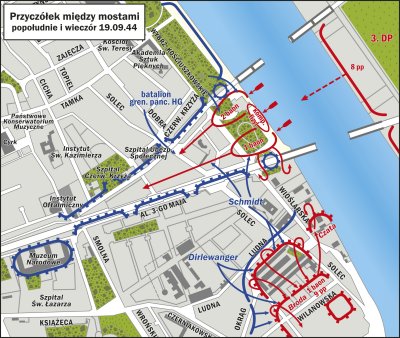
Landing and first phase of fights in the beachhead between bridges in Warsaw, September 19th, 1944, Fig. by Piotr Wawrzkiewicz;
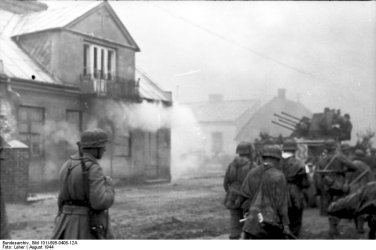
German photograph which most probably shows the unit of "Herman Göring" Paratroop Panzer Division during the fights in Wola District (Warsaw) in the first days of August 1944.
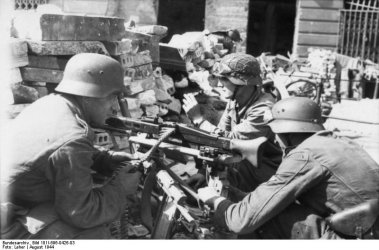
German MG-42 machine gun position in Warsaw;
Summary
It seems that the evening of September 19th and the night of September 19th to 20th were decisive for the further fight. It was then when hope for the successful operation of the 8th IR disappeared. Instead of attacking alongside the riverbank towards the bridgehead in Czerniakow (in compliance with the theoretically planned operation), the sub-units of this regiment were advancing only to the west - towards Srodmiescie District. When the regiment transported its main forces on the west riverbank, there was no one of the command there. All the officers of the 2nd Battalion's command got wounded, while radio sets drowned in the Vistula River. The forces that landed were practically left without the command nor radio communication with the east bank. Apart from the evacuation of the wounded, which took place ad hoc during the landing, several soldiers made the attempt of swimming back across the river already in the night of September 19th to 20th.
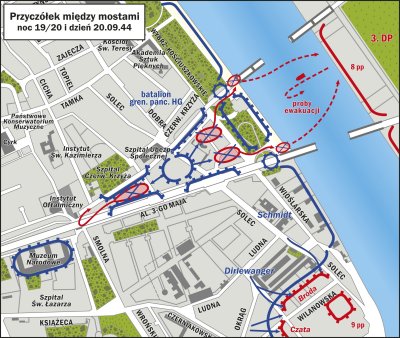
Second phase of fights and liquidation of the beachhead, September 19/20 and 20, 1944. Fig. by Piotr Wawrzykiewicz.
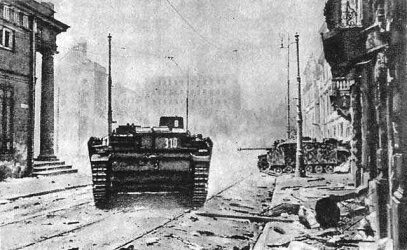
German StuG III assault gun in the streets of Warsaw during the Uprising;
Controversies
Why, after having landed on the left side of the Vistula River, the units of 8th IR did not head to the south, towards the bridgehead in Czerniakow - which, according to the theory of J. Margules, was the main and only aim of the landing, and headed to the west, to join with Srodmiescie District? Was it expcetionally unresponsible wilfulness of ordinary soldiers or the officers who were giving them orders. Or was it that the most important objective of the landing was the cooperation with the insurgent Srodmiescie District, and not with Czerniakow?
This theory is corroborated by the factual actions of the 8th IR's battalions on the left riverbank, who were advancing only towards west, and not to the south. It is also confirmed by the recollections of soldiers, e.g. this fragment (source: Kaczmarek Kazimierz "Osmy Bydgoski", Warszawa 1962, s.113): "We expected to see insurgents in windows, basements and on the roofts, but we only found sharpshooters there".
Jozef Margules presented his thesis (based on the orders) in the books published in 1962 ("Przyczolki Warszawskie" [eng. "Warsaw Bridgeheads"]) and in 1967 ("Boje 1 Armii WP w obszarze Warszawy sierpien - wrzesien 1944" [eng. "Battles of Polish First Army in Warsaw, August-September 1944"). Other perspective is revealed by Zygmunt Berling in a fragment of his memoirs, which were published in 1981 ("Rzeczywistosc" nr 10, July 26, 1981 ["Reality"]). On the basis of the above, General Berling was to have known about the attack of the insurgents of Srodmiescie District alongs Al. 3 Maja street towards the Vistula River.
The Commander-in-Chief of the Polish Army was probably counting on the cooperation of the Polish People's Army (PAL), because he stated in his memoirs that the failure of the operation of the Polish First Army on the Warsaw bridgeheads ocurred due to the fact that he had "Germans, the front commander and the commmander of the Warsaw Uprising" against himself. From the abovementioned fragment it results that Berling was thinking about the commander of the PAL, Colonel "Zaborski" Julian Skokowski when writing "the commander of the Warsaw Uprising". The PAL forces that were fighting in the uprising amounted to about 500 poorly armed soldiers, dispersed in different parts of isolated districts of Warsaw. They could not in any possible way launch offensive actions the commander of the Polish First Army was seemingly counting on.
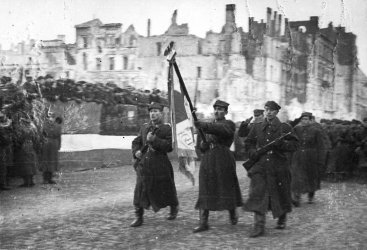
Military parade in the city ruins - It was not until January 17th, 1945, that Polish forces liberated the destroyed and demolished Warsaw;
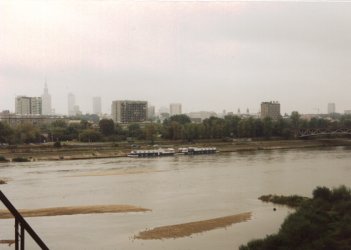
Contemporary view on the area between bridges from the east end of Poniatowski Bridge (September 4th,2004, by Sz. Nowak); ;
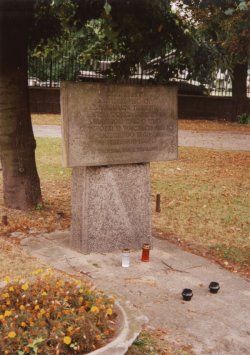
The plaque in Al. 3 Maja street (near the Museum of the Polish Army) commemorating the farthest limit of advance of the soldiers of the 8th IR, 3rd ID in September, 1944. Inscription says: "To the soldiers of the 3rd Infantry Division "Romuald Traugutt" of the Polish First Army, heroes of the battles for the Vistula River and the bridgeheads in the fighting capital who advanced to this place in September, 1944. September 17th, 1981, Warsaw (taken on September 4th, 2004, by Sz. Nowak);
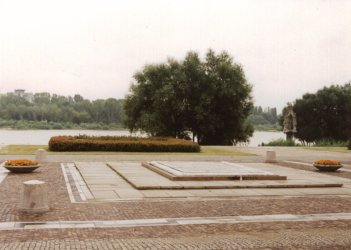
The Landing Plate commemorates the soldiers of the 3rd IR who died in fights for bridgeheads (taken on September 4th , 2004, by Sz. Nowak)
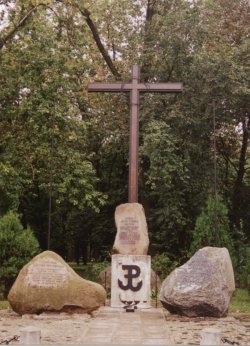
The cross at 1 Wilanowska street in Czerniakow in the place of the insurgents redoubt - the inscriptions engraved on three boulders commemorate those who fell in Czerniakow: Fr. Jozef Stanko "Rudy", Captain Andrzej Romocki "Morro", soldiers of "Siekiera-Kryska", "Radoslaw" Groups, and the 3rd Infantry Division "Romuald Traugutt" (taken on September 4th , 2004, by Sz. Nowak)
Szymon Nowak
Bibliography:
1. Berling Zygmunt, Wspomnienia. Tom 3. Wolność na przetarg, Warszawa 1991;
2. Borkiewicz Adam, Powstanie Warszawskie. 1944. Zarys działań natury wojskowej, Warszawa 1964;
3. Dańko Bolesław, Nie zdążyli do Andersa. Berlingowcy, Londyn 1992;
4. Encyklopedia II wojny światowej, Warszawa 1975;
5. Jaczyński Stanisław, Zygmunt Berling, Między sławą a potępieniem, Warszawa 1993;
6. Kaczmarek Kazimierz, Ósmy Bydgoski, Warszawa 1962;
7. Kempa Wojciech, Na przedpolu Warszawy, Siemianowice Śląskie 2007;
8. Kwiatkowski Maciej Józef, Tu mówi powstańcza Warszawa... Dni Powstania w audycjach Polskiego Radia i dokumentach niemieckich, Warszawa 1994;
9. Margules Józef, Boje 1 Armii WP w obszarze Warszawy (sierpień - wrzesień 1944), Warszawa 1967;
10. Margules Józef, Przyczółki Warszawskie, Warszawa 1962;
11. Rozwadowski Piotr, Warszawa 1944-1945, Warszawa 2006;
12. Sawicki Tadeusz, Czy Armia Czerwona mogła uratować Powstanie Warszawskie, Wojskowy Przegląd Historyczny nr 2/1989;
13. Sawicki Tadeusz, Rozkaz: zdławić powstanie. Siły zbrojne III Rzeszy w walce z Powstaniem Warszawskim 1944, Warszawa 2001;
14. Wczoraj i dziś Trauguttowców. Wydanie okolicznościowe. 45 rocznica powstania 3 Pomorskiej Dywizji Piechoty im. Romualda Traugutta 1943-1988, Warszawa 1988;
15. Wyganowska-Eriksson Anna, Pluton pancerny Batalionu Zośka w Powstaniu Warszawskim, Gdańsk 2010.
Attention! The complete text can be found in the special issue 6(39)/2010 of the "Militaria XX w." magazine.
translation: Paweł Boruciak
Copyright © 2011 SPPW1944. All rights reserved.